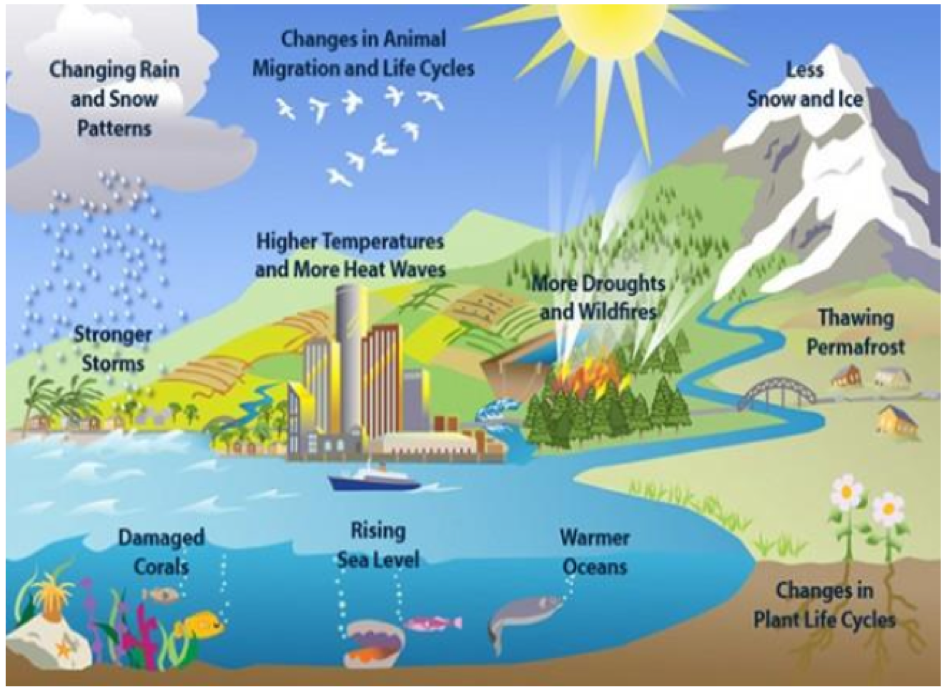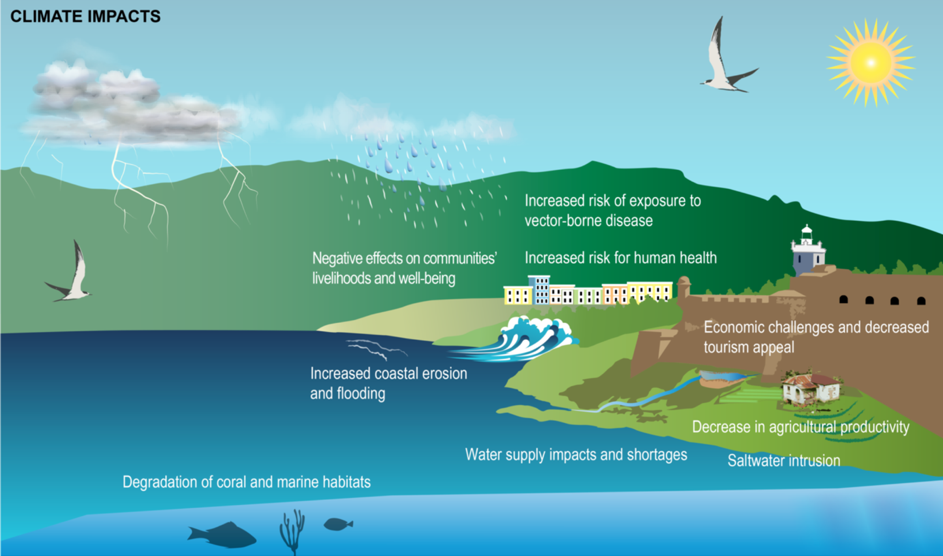3.1. Climate Change in the Caribbean
Climate Change
Rising fossil fuel burning and land use changes emit increasing quantities of greenhouse gases into the Earth’s atmosphere. These greenhouse gases include carbon dioxide (CO2), methane (CH4) and nitrogen dioxide (N2O). An increase in these gases has caused a rise in the amount of heat from the sun withheld in the Earth’s atmosphere, heat that would normally be radiated back into space. This increase in heat has led to an increase in the natural greenhouse effect, resulting in climate change.
The main characteristics of climate change are increases in average global temperature (global warming); changes in cloud cover and precipitation particularly over land; melting of ice caps and glaciers and reduced snow cover; and increases in ocean temperatures and ocean acidity – due to seawater absorbing heat and carbon dioxide from the atmosphere.

Climate Change Impacts in the Caribbean
Climate change impacts on water resources in the Caribbean are predicted to result in a decrease in annual precipitation, increase flooding and extreme rain events, sea surface temperature rise, ocean acidification, sea level rise, and saltwater intrusion and inundation.
Studies indicate that some locations within the Caribbean may experience longer dry seasons and shorter, but wetter, wet seasons in the future. There will be a decrease in summer rainfall in the Caribbean in the vicinity of the Greater Antilles, with possible wetter conditions in the northern Caribbean. The dry season will be drier and longer, and hurricanes will be more intense. These changes in rainfall patterns and intensity will also impact agriculture. Excessive rainfall coupled with poor construction practices, unpaved roads, and steep slopes, which are typical of the Caribbean islands, can exacerbate erosion rates and reduce reservoir capacity, water quality, and nearshore habitat quality.
Sea level rise is another climate-related stressor in the Caribbean. The rate of sea level rise in the region is expected to follow or exceed global projections. Coastal mangroves may be reduced in extent, diminishing the natural protection they provide against the action of waves and storm surge and limiting their role as wildlife habitat. For example, studies have projected that 3 per cent of Cuba’s mangrove forests may be lost with a one meter rise in sea level. For the same rise in sea level, a complete collapse of the Port mangrove wetland in Jamaica is predicted, since this system has shown little capacity to migrate over the last 300 years (UNFCCC, 2007).
Coastlines will almost certainly suffer from accelerated coastal erosion as well as inundation of settlements and arable land. For example, in Grenada, a 50 cm rise in sea level could lead to 60 per cent of beaches in some areas being lost (UNFCCC, 2007).
Marine ecological systems provide key services such as fisheries and coastal protection. These systems are threatened by changes in ocean surface temperature, ocean acidification, sea level rise, and changes in the frequency and intensity of storm events. Degradation of coral and other marine habitats can affect the distribution of fish and other species. With current high levels of greenhouse gas emissions, mass coral bleaching in the Caribbean may occur at least twice a year within the next decade (USGCRP, 2018).
Climate change is also likely to have other negative effects on tourism in the region. The increasing frequency and severity of extreme weather, sea level rise and accelerated beach erosion, degradation of coral reefs (including bleaching), and the loss of cultural heritage on the coasts through inundation and flooding, are likely to reduce the attractiveness of Small Island Developing States (SIDS) to tourists. For example, in Barbados 70 per cent of the hotels are located within the 1 in 500 years and 1 in 100 years inundation zones, placing them at risk of major structural damage (UNFCCC, 2007).
Note: see the Resources section for a video highlighting the impact of climate change on tourism in the Caribbean
These climatic impacts will likely disrupt valuable ecosystem services, seriously affecting the economy of many small islands. Impacts at the community level, apart from economic effects, involve recognising that men and women are experiencing the effects of climate change in different ways.

Video: 5 Things You Should Know About Climate Change in the Caribbean (4:15 min)
Watch the video of the Caribbean Community Climate Change Center on 5 Things You Should Know About Climate Change in the Caribbean.
Resilience, risk and adaptation
Climate resilience. The ability of a social or ecological system to resist, absorb, accommodate and recover from the effects of a (climate) hazard in a timely and efficient manner while retaining the same basic structure and ways of functioning (GWP-C and CCCCC 2014).
Climate risk management. Climate risk can be defined simply as the probability of a given climate event occurring and the adverse consequences of this. However, IPCC (2012) gives the definition as the likelihood of unfavourable impacts occurring as a result of severe climate events interacting with vulnerable environmental, social, economic, political or cultural conditions. The process of applying such risk information to decision making, including identification, assessment and prioritization of the risks followed by application of resources to reduce, monitor and control the probability and/or impact of detrimental effects, is known broadly as climate risk management (CRM).
Climate change adaptation. Adaptation is a process through which societies make themselves better able to cope with an uncertain future. Adapting to climate change entails taking the right measures to reduce the negative effects of climate change (or exploit the positive ones) by making the appropriate adjustments and changes.
